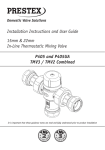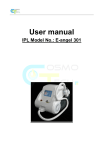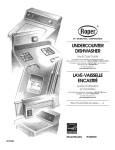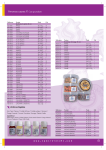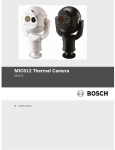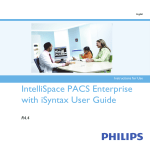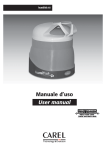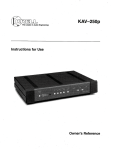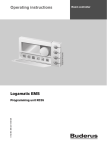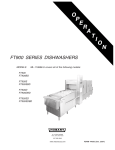Download Installation Instructions and User Guide 15mm
Transcript
Installation Instructions and User Guide 15mm & 22mm Thermostatic Mixing Valve TMV3 / TMV2 Combined Valve C85079 C85081 C85080 C85082 It is important that these guidance notes are read and fully understood prior to product installation The Pegler Yorkshire Model P405 mixing valve must be installed in accordance with the reg local water company and the Water Supply (Water Fittings) Regulations 1999. Approvals Bulldog TMV When used as a TMV3 (TYPE3) valve: IMPORTANT INTRODUCTION NOTES The valves covered by these instructions have been tested and certified as being in compliance with BS 7942:2000 and NHS Estates Model Engineering Specification D 08. Valves operating outside the requirements of these standards are not covered by the TMV3 Scheme and are not guaranteed to operate as Type 3 valves. alves The installer should be aware of his duty of care and responsibility in ensuring that compliance with regulations is maintained. The valve is not guaranteed to function correctly to the TMV3 specification unless it is installed and used in accordance with these instructions. Regular servicing is essential to ensure continued safe operation of this thermostatic mixing valve. The operating outside thesemust conditions recommended service interval be based on can the not valve response to the in-service cold water failure test results. strainers should beunder installed as close as practicable This product is certified the BuildCert TMV3 scheme and has beento independently tes recognised test laboratory WRc-NSF valve and is a and Watershould Regulations Advisorybe Scheme (WRAS) the location of the mixing always product and listed in the Water Fittings and Materials Directory. in an accessible location. Installation Before thebehot andoncold water supply Separateinstallation, isolation valves must installed the hot and cold water inlet supplies. To ens performance of the mixingflushed valve, the to isolating valvesany should preferably be ful systems must bethermostatic thoroughly remove always be fully open during operation. dirt/debris that may have accumulated. do The mixing valve is supplied with filter elements but it isFailure advisableto to additionally install on the hot and cold water supplies. The isolating valves and strainers should be soY-strainers may adversely affect the performance of the close as practicable to the location of the mixing valve and should always be in an accessib mixing valve. Before installation, the hot and cold water supply systems must be thoroughly flushed to re dirt/debris that may have accumulated. Failure to do so may adversely affect the performa mixing valve. Conditions of normal Use CONDITIONS OF NORMAL USE Table 1 Table 1 Operating Range High Pressure Low Pressure Maximum static pressure - bar 10 10 Hot & cold flow pressure - bar 1.0 to 5 0.2 to 1 Hot supply temperature - °C 52 to 65 52 to 65 Cold supply temperature - °C 5 to 20 5 to 20 Minimum hot inlet to mixed outlet temperature differential =10°C Minimum hot inlet to mixed outlet temperature differential =10°C Note: Valves operating outside these conditions can be guaranteedby by the to operate as Type be not guaranteed theScheme Scheme to operate as Ty 3 valves. The highest flow rates will be achieved under balanced pressure conditions, but the pressure at the valve This rates Bulldog will TMV by Yorkshireunder Model P405 hest flow bePegler achieved balanced pressure conditions, but the pressure at the val inlets must be within a ratio of 5:1 under flow in-line thermostatic mixing valve, available in ust be 15mm within a ratio of 5:1 under flow conditions and the and ofofpipework conditionssize and the sizelayout and layout pipework andand fitting and 22mm sizes, is intended to be fitted into fittings must take this into account. ke this applications into account. where the reliable control of hot water temperature is necessary to prevent scalding. In the event of cold water supply failure, the product will shut off the hot water supply. FITTING Before installation, the system operating conditions of pressures, hot water temperature and hot and and hot a Water the regulations nstallation, system operating conditions of inletinlet pressures, hot water temperature cold water flow rates should be determined and ter flow rates should be determined and confirmed confirmed to be within thethe expected conditions of norm to be within expected conditions of The Bulldog TMV mixing valve must be installed in accordance with the regulations of the local water company and the Water Supply (Water Fittings) Regulations operate in1999. either a high pressure setting normal use. Valves must operate in either a high pressure setting must or a low pressure setting valves not or a low pressure setting valves are not are capable of capable o operation with, for instance hot water supply in on with,Approvals for instance hot water supply in one pressure range and cold water supply inone the other cold water supply in the other e range. In these conditions it is necessary to eitherpressure boostrange oneandpressure or reduce the other so pressure range. In these conditions it is necessary to This product is certified the BuildCert TMV3 range. h supplies are within a under common pressure either boost one pressure or reduce the other so scheme and has been independently tested by the that both supplies are within a common pressure recognised test laboratory WRc-NSF and is a Water range. Regulations Advisory Scheme (WRAS) approved product and mixing listed in the Water is Fittings and Materials location of the valve important to ensure Correct that itlocation is accessible commissioning of the mixingfor valve is important to Directory. ensure that it is accessible for commissioning and g. servicing. Installation • The valve body is clearly marked with Separate isolation valves must be installed on the hot for Cold and a valve body is clearly marked with ‘C’ for Cold and a ‘C’ blue and cold water inlet supplies. To ensure proper blue indicator and cator and ‘H’ for Hot and a red indicator. performance of the thermostatic mixing valve, the ‘H’ for Hot and valve must correctly connected to the isolatingbe valves should preferably be full bore and respective supplies. a red indicator. The always be fully open during operation. valve must be The mixing valve is supplied with filter elements but correctly connected it is advisable to additionally install Y-strainers on the to the respective hot and cold water supplies. The isolating valves and supplies. and 2 use of sealing compounds must be avoided since they may intrude into the water supply and this arrangement is used, the requirements for isolation valves and Y-strainers regarded as fulfilled. • The use of sealing compounds must avoided valve Exploded view ofbeangled since they may intrude into the water supply and impair the valve performance. Exploded view of angled valve assembly assembly The Pegler Model Yorkshire P405UA mixing valve is optionally p the tailpiece arrangement shown above. This allows the connec be parallel to the mixed water outlet for ease of piping layouts. non-return valves, filters, isolation valves and test points The Bulldog TMV thermostatic mixing valve is supplied with the tail pieces, inlet filter screen and main body gasket seals separately located in the packing box. Each tail piece comprises: a housing with union nut and an internally fitted, WRAS approved non-return valve. The assemblies comprise an integral full bore ball valve and inthis arrangement is used, the requirements for isolation valves regarded as fulfilled. Assembly Procedure • • • • • • Unpack the main valve assembly and check that the Exploded view of angled valve assembly bores are free of debris and the end sealing faces are clean. Unpack the two tailpieces and confirm they are complete with union nuts and compression nuts and olives. Locate the sealing gaskets, insert them into the union nuts against the faces of the tailpieces and screw the union nuts onto the valve until a tight APPLICATION seal has been made. Application Remove the compression nuts and olives from the The Pegler Yorkshire Model mixing valve has been independently t tailpieces. Locate the inlet filter screens andP405 insert thermostatic The Bulldog TMV thermostatic mixing valve has them intorequirements the bore of the tailpieces to the the of BS up7942:2000 and NHS D08 and certified as complying with the been independently tested by WRc-NSF against shoulder. the requirements of BS 7942:2000 and NHSbelow. D08 Scheme and is suitable for use in the designations shown in the table Assemble the valve to the pipework and ensure the andAPPLICATION certified as complying with the requirements hot and cold water pipes have full penetration into of the TMV3 Scheme and is suitable for use in the The use Pegler ‘HP’ Yorkshire Model P405 mixing valve has been theValves tailpiece. approved for designation for only:athermostatic water designations shown in theIftable below. supply is fed by the requirements of BS 7942:2000 and NHS D08 and certified as com Tighten the compression nuts ensuring that the end supply pressure should be verified to ensure theis suitable conditions oftheuse are appropriate for Scheme and for use in designations shown in the table of the pipe remains in contact with the filter Valves approved for designation for use ‘HP’ only:element. If a water supply is fed by gravity then the supply Valves approved for designation for use ‘HP’ only:- If a water s pressure should be verified to ensure the the conditions supply pressure should be verified to ensure conditions of use are Exploded view of tail pipe assembly Exploded view of tail pipe assembly of use are appropriate for the valve. Table 2 – Required maximum set outlet Table 2 – Required maximum set outlet temperatures at commissioning. temperatures at commissioning. Table 2 – Required maximum set outlet temperatures at com Application Bidet Designation HP-B Application Designation Maximum Set Mixed Water Temperature Bidet HP-B LP-B 38°C Shower HP-S Maximum Set Mixed Water Temperature 38°C 41°C The Bulldog TMV mixingP405UA valve is optionally provided LP-B valve LP-S The Pegler Model Yorkshire mixing is optionally provided with angled assemblies in lieu of with angled assemblies in lieuabove. of the tailpiece Washbasin HP-W 41°C to the tailpiece arrangement shown This allows the connections of the hot and cold water supplies Shower HP-S 41°C arrangement shown above. This allows the connections LP-Wassemblies incorporate be parallel to the mixed water outlet for ease of piping layouts. The angled valve of the hot and cold water suppliesLP-S to be parallel to non-return valves, filters, isolation valves and test points Bath* HP-T44 44°C the mixed water outlet for ease ofHP-W piping layouts. The Washbasin 41°C LP-T44 angled valve assemblies incorporate non-return valves, Bath* HP-T46 46°C LP-W filters, isolation valves and test points. (assisted) LP-T46 The assemblies comprise an integral fullfull bore strainer in an angled housing. When The assemblies comprise an integral boreball ballvalve and in-line *22mmonly only this arrangement is used, the in requirements for isolation valves *22mm and Y-strainers previously mentioned are valve and in-line strainer an angled housing. regarded as fulfilled. When this arrangement is used, the requirements for The range of available temperature adjustment is 35°C to 48°C BUT isolation valves and Y-strainers previously mentioned theThe terminal should never be set to a temperature tha range offitting available temperature adjustment is areview regarded as fulfilled. outlet for the application (Table 2). Exploded of angled valve assembly 35°Ctemperature to 48°C BUT the mixed water temperature at the terminal fitting should never be set to a Note: temperature that exceeds the maximum set outlet 46°C is the maximum recommended mixed water temperature from t temperature for the application (Table 2). 3 takes account of the allowable temperature tolerances inherent in the losses in metal baths. 46°C is not a safe bathing temperature for adults or children. Note: • • 46°C is the maximum recommended mixed water temperature from the bath tap. The maximum temperature takes account of the allowable temperature tolerances inherent in thermostatic mixing valves and temperature losses in metal baths. 46°C is not a safe bathing temperature for adults or children. Bath* HP-T44 44°C The British Burns Association recommends 37°C to LP-T44 37.5°C Bath* as a comfortable HP-T46 bathing temperature 46°C for children. In premises (assisted) LP-T46 covered by the Care Standards Act 2000, the maximum mixed water outlet temperature *22mm only is 43°C. using a close fitting spanner, reduce the mixed outlet temperature by turning clockwise. increase the mixed water outlet temperature by turning counter clockwise. When the valve has been installed with the correct conditions of use it is advised that the valve is subjected to exercise prior to the commissioning at the application temperature. With hot and cold water flowing through the valve, operate the valve from full cold to full hot at least three times. With the valve at the full cold position bring the valve to the correct application temperature by turning the spanner counter clockwise. If the valve overshoots thisthe temperature, returntemperature the valve to theatfull cold The range of available temperature mixed water COMMISSIONING (TMV 3) adjustment is 35°C to 48°C BUT condition, and the resetmaximum it to the correct the terminal fitting should never be set to a temperature that exceeds set temperature +0-2°C. Do not set a valve on a lowered temperature valve must be under (Table normal site outlet The temperature forcommissioned the application 2). as this will not provide consistent operation. system conditions and after establishing supply Note: conditions with the hot and cold water supplies open, When set maximum to the required temperature for the systemrecommended running to allow temperatures and 46°C is leave the maximum mixed water temperature from the the bathvalve tap.isThe temperature the applicationmixing carry out 5 cold isolation tests takes account ofto the allowable valves andwater temperature pressures stabilise and temperature be checked. tolerances inherent in thermostatic to further exercise the valve. losses in metal baths. commissioning, thefor following 46°C isPrior nottoa commencing safe bathing temperature adults or children. Commissioning Test sequence checks should be carried out. The British Burns Association recommends 37°C to 37.5°C as a comfortable bathing temperature for children. adjust thebring temperature water in • Thecovered designation of the thermostatic valve maximum In premises by the Care Standards mixing Act 2000, the mixed water outlet is 43°C. With the valve at the fullAfter cold position thetemperature valveoftothe themixed correct application tempera accordance withovershoots the valve application (see Table matches the application. spanner counter clockwise. If the valve this temperature, return the valve to 2) and the carry out the following sequence: COMMISSIONING (TMV 3)and temperaturescondition, • The supply pressures are withinand reset it to the correct temperature +0-2°C. Do not set a valve on a lower 1.Record the temperature of the hot and cold water this will not provide consistent operation. the operating range of the valve. supplies. The valve must be valves commissioned under site system conditions and after establishing • Isolating and strainers are normal provided. When set to2.Record the system required temperature forthe the application therunning temperature of mixed water carry at theout 5 cold wa supply conditions with the hot and water supplies open,is leave the to allow temperatures • The supply temperatures arecold within the rangethe valve to further largest draw-off flow rate. and pressures to stabilise checked. permitted for the and valvebeand by guidance exercise the valve. 3.Record the temperature of the mixed water flow information on the prevention of legionella etc. Commissioning Testbe sequence carried at a smaller Prior to commencing commissioning, the following checks should out. draw-off flow rate, which shall be measured. If all these conditions are met, proceed to set the After adjust temperature of thethe mixed accordance with thevalve valve application 4.Isolate cold water water in supply to the mixing • temperature The designation of the below. thermostatic mixing matches the application. as described The Bulldog TMVvalvethe 2) and the carry out the following sequence: and range monitor • thermostatic The supply mixing pressures temperatures ofthe themixed valve.water temperature recording valveand is supplied factoryare set within the operating 1. Record the temperature of the hot and cold water supplies. the maximum temperature achieved and the final • atIsolating andmay strainers are adjusted provided.after 43°C butvalves the valve be simply 2. Record the temperature of the mixed water at the largest draw-off flow stabilised temperature. • installation. The supply temperatures are within the range permitted forthe the valve and bythe guidance information 3. Record temperature of mixed water flow at a smaller draw-off fl 5.Record the equipment, thermometer etc. used for on the prevention of legionella etc which shall be measured. thethe measurements. If all these conditions met, proceed to set the temperature as described below. The mixed waterare temperature at the terminal fitting 4. Isolate cold water supply to the mixing valve and monitor the mixed Note:factory The final stabilised should not and the fina The Pegler model thermostatic mixing valve temperature is supplied setthe at maximum 43°C temperature but temperature the valve may mustYorkshire never exceed theP405 maximum temperature recording achieved exceed the values in Table 3. be simply adjusted after installation. setting for the particular application (See Table 2). temperature. 5. Record the equipment, etc. used for the measurements. The mixed temperature at the terminal fitting must never exceed thermometer the maximum Note, water It is not possible to install one thermostatic Note: The final stabilised temperature should not exceed the values in Table3 temperature setting for the particular application (See Table 2). 3 Note, It is to not possible to install mixing valve to supply two differing applications Table – Guide maximum stabilised one thermostatic mixing valve tohigher supply two differing applications unlessrecorded the temperature unless the temperature of the setting is temperatures during of the higherlimited settingtoisthat limited thatapplication. of the lower application. commissioning of thetolower Table 3 – Guide to maximum stabilised temperatures recorded during comm • •Remove capon ontop topofofthe the valve with the supplied Allen key or other suitable tool. Removethe the plastic plastic protective protective cap Application Mixed water temperature °C valve with the supplied Allen key or other suitable Bidet 40 tool. o using a close fitting spanner, Shower 43 reduce theWashbasin mixed outlet 43 temperature turning Bath by (44°C fill) 46 clockwise. Bath (46°C fill) 48 o increase the mixed water outlet temperature by turning counter clockwise. 4 After correct commissioning secure the protective cap u supplied screw. The Pegler Yorkshire model P405 is sup two protective caps. One blue TMV 3 cap and one whit Ensure that the blue colour TMV 3 cap is fitted as this w With an acceptable mixed water temperature complete the Commissioning test sequence detailed above. If the final mixed water temperature is greater than the values in Table 3 and/or the maximum temperature exceeds the corresponding value from the previous test results by more than about 2°C the need for service work is indicated (see TMV servicing and cleaning instructions). In-service tests should be carried out with a frequency which identifies a need for service work before an unsafe water temperature can result. Frequency of in-service testing 6 to 8 weeks after commissioning carry out the test sequence detailed above. 12 to 15 weeks after commissioning carry out the test sequence detailed above. Depending on the results obtained, the following course of actions must be followed: After correct commissioning secure the protective cap using the supplied screw. The Bulldog TMV model is supplied with two protective caps. One blue TMV 3 cap and one white TMV 2 cap. Ensure that the blue colour TMV 3 cap is fitted as this will indicate the valve has been commissioned to the TMV 3 standard. • • • • In Service Testing (TMV 3) The purpose of in-service testing is to regularly monitor and record the performance of the thermostatic mixing valve. Deterioration in performance can indicate the need for service work on the valve and/or water supplies. Carry out the test sequence detailed below using the same or equivalent equipment as used for commissioning the valve. • • • • Check the designation of the thermostatic valve matches the application. Check that the supply pressures and temperatures are within the operating range of the valve. Check that the supply temperatures are within the range permitted for the valve and by guidance information on the prevention of legionella etc Check there have been no significant changes in inlet supply temperatures and pressures since commissioning or the previous in service test. If significant changes have occurred it is recommended to re-commission the valve. If the mixed water temperature has changed significantly from the previous test results (e.g.>1°C), record the change and before re-adjusting the mixed water temperature carry out the following checks; • • • If no significant changes (e.g.<1 °C) in mixed water temperature are recorded between commissioning and testing at 6 to 8 weeks, or between commissioning and testing at 12 to 15 weeks, the next in-service test can be deferred to 24 to 28 weeks after commissioning. If small changes (e.g.1 to 2 °C) in mixed water temperature are recorded in only one of these periods, necessitating adjustment of the mixed water temperature, then the next inservice test can be deferred to 24 to 28 weeks after commissioning. If small changes (e.g.1 to 2 °C) in mixed water temperature are recorded in both of these periods, necessitating adjustment of the mixed water temperature, then the next in-service test should be carried out at 18 to 21 weeks after commissioning. If significant changes (e.g. >2 °C) in mixed water temperature are recorded in both of these periods, necessitating service work, then the next in-service test should be carried out at 18 to 21 weeks after commissioning. The general principle to be observed after the first 2 or 3 in-service test is that the intervals of future tests should be set to those which previous tests have shown can be achieved with no more than a small change in mixed water temperature. It is recommended that In-Service Tests are carried out once every 6 months as a minimum. Note: All in-line or integral strainers are clean Any in-line or integral non-return valves or other anti-backsiphonage devices are in good working order. Any isolation valves are fully open. 5 If there is a residual flow during the commissioning or in service test during the cold water supply isolation test then this is acceptable providing the temperature of the water seeping from the valve is no more than 2°C above the designated maximum mixed water outlet temperature setting of the valve as defined in Table 2. Temperature readings should be taken at the normal flow rate after allowing the system to stabilise. The sensing part of the thermometer probe must be fully submerged in the water that is to be tested. The mixing valve is supplied with filter elements but it is advisable to additionally install Y-strainers on the hot and cold water supplies. The isolating valves and strainers should be installed as close as practicable to the location of the mixing valve and should always be in an accessible location. Any TMV that has been adjusted or serviced must be re-commissioned and re-tested in accordance with the manufacturer’s instructions. Before installation, the hot and cold water supply systems must be thoroughly flushed to remove any dirt/debris that may have accumulated. Failure to do so may adversely affect the performance of the mixing valve. Bulldog TMV When used as a TMV2 (TYPE 2) Valve IMPORTANT INTRODUCTION NOTES The valves covered by these instructions have been tested and certified as being in compliance with BS EN 1111:1999 and BS EN 1287:1999. CONDITIONS OF NORMAL USE CONDITIONS OF NORMAL USE Table 4 Valves operating outside the requirements of these standards are not covered by the TMV2 Scheme and are not guaranteed to operate as Type 2 valves. Table 4 Operating Range Maximum static pressure - bar Hot & cold flow pressure - bar Hot supply temperature - °C Cold supply temperature - °C Mixed water temperature - °C BS EN 1111 High Pressure 10 1.0 to 5 55 to 65 ≤ 25 Maximum 46 BS EN 1287 Low Pressure 10 0.1 to 1 55 to 65 ≤ 25 Maximum 46 The installer should be aware of his duty of care and responsibility in ensuring that compliance with Minimum hot inlet to mixed outlet temperature differential =10°C Minimum hot inlet to mixed outlet temperature regulations is maintained. The valve is not guaranteed Note: Valves operating outside these conditions can not be guaranteed by the Scheme to operate as T 2 valves. differential =10°C to function correctly to the TMV2 specification unless it is installed and used in accordance with The highest flow rates will be achieved under balanced pressure conditions, but the pressure at the va Note: Valves outside these conditions can inlets must be within a ratio operating of 5:1 under flow conditions and the size and layout of pipework and fittin these instructions. Regular servicing is essential to must take this into account. not be guaranteed by the Scheme to operate as Type ensure continued safe operation of this thermostatic 2 valves. mixing valve. The recommended service interval is no FITTING greater than 12 months. Before installation, the system operating conditions of inlet pressures, hot and cold inlet temperature a hot and cold flow rates should be determined confirmedunder to be within the expected condition Thewater highest flow rates will be and achieved balanced of normal use shown in Table 4. pressure conditions, but the pressure at the valve This Bulldog TMV thermostatic mixing valve, available must operate in either high pressure setting a lowunder pressureflow setting. These valves are not inlets must be awithin a ratio ofor5:1 in 15mm and 22mm sizes, is intended to be fitted into Valves capable of operation with, for instance hot water supply in one pressure range and cold water supply theconditions size and pipework and the other conditions pressure range.and In these it is layout necessaryof to either boost one pressure or reduce th applications where the reliable control of hot water other so that both supplies within a common pressure range. fittings mustare take this into account. temperature is necessary to prevent scalding. In the If your water supply cannot meet these conditions then the valve cannot be guaranteed to operate as Type 2 valve. event of cold water supply failure, the product will shut off the hot water supply. OperatingFITTING pressures above 5.0 Bar will require the installation of a pressure reducing valve. Water regulations The Bulldog TMV mixing valve must be installed in accordance with the regulations of the local water company and the Water Supply (Water Fittings) Regulations 1999. Approvals This product is certified under the BuildCert TMV2 scheme and has been independently tested by an approved testing laboratory WRc-NSF and is a Water Regulations Advisory Scheme (WRAS) approved product and listed in the Water Fittings and Materials Directory. Correct location of the mixing valve is important to ensure that it is accessible for commissioning and servicing. Before installation, the system operating conditions of inlet pressures, hot and cold inlet temperature and The valve body is clearly marked with ‘C’ for Cold and a blue hotand and flow rates should be determined indicator, ‘H’ cold for Hotwater with a red indicator. The valve must be correctly connected to the respective supplies. and confirmed to be within the expected conditions of normal use shown in Table 4. • • The use of sealing compounds must be avoided since they may intrude into the water supply an impairValves the valvemust performance. operate in either a high pressure setting • The valve must be so installed that it is readily accessible for commissioning and maintenance wh beingcapable installed in of accordance with TMV2. operation with, for instance hot water • The valve must be installed with isolation valves on both the hot and cold water systems as close possible the valve; so as to allow the valve be commissioned and it tested theto other pressure range. In to these conditions is correctly. or a low pressure setting. These valves are not supply in one pressure range and cold water supply in necessary either pressure orwater reduce thetherefore in-line The valve is suppliedto with integralboost strainersone on the hot and cold supplies strainers should be required. other sonotthat both supplies are within a common • pressure range. If your water supply cannot meet these conditions then the valve cannot be guaranteed to operate as a Type 2 valve. Installation Separate isolation valves must be installed on the hot and cold water inlet supplies. To ensure proper performance of the thermostatic mixing valve, the isolating valves should preferably be full bore and always be fully open during operation. Operating pressures above 5.0 Bar will require the installation of a pressure reducing valve. Correct location of the mixing valve is important to ensure that it is accessible for commissioning and servicing. 6 Exploded view of tailpiece assembly • The valve body is Exploded view of tail pipe assembly ld and a clearly blue marked with ‘C’ for Cold and a blue indicator and ‘H’ for Hot and supplies. a red indicator. The valve must be Pegler Model Yorkshire P405UA mixing valve is optionally provided with an The correctly connected the tailpiece arrangement shown above. This allows the connections of the hot to the respective ease piping layouts. angled valv supplies. be parallel to the mixed water outlet The for Bulldog TMV of mixing valve is optionallyThe provided they may intrude into the water supply and The Pegler Model Yorkshire P405UA mixing valve is optionally p with angledand assemblies in lieu of the tailpiece non-return valves, filters, isolation valves test points the tailpiece arrangement shown above. This allows the connec • The use of sealing compounds must be avoided arrangement shown above. This allows the connections be parallel to theand mixed outlet for ease of piping since they may intrude into the water supply and of the hot cold water water supplies to be parallel to the layouts. non-return filters,forisolation valveslayouts. and test points impair the valve performance. mixedvalves, water outlet ease of piping spective since g valve is supplied with the tail pieces, inlet filter The assemblies comprise an integral full bore ball ed in the packing box. • The valve must be so installed that it is readily valvefull andbore in-line ball strainer in an angled housing. strainer in a The assemblies comprise an integral valve and in-line accessible forfitted, commissioning andapproved maintenance non-return When this arrangement is used, the requirements for and an internally WRAS arrangement is used, requirements for valves and when being this installed in accordance with TMV2. theThe assemblies comprise an integral full bore ballY-strainers valve isolation valves andisolation strainers previously mentioned are and inregarded as fulfilled. this arrangement is used, the requirements for isolation valves regarded as fulfilled. • The valve must be installed with isolation valves on regarded as fulfilled. both the hot and cold water systems as close as Exploded view of angled valve assembly possible to the valve; so asview to allow valve tovalve be Exploded of the angled assembly Exploded view of angled valve assembly commissioned and tested correctly. that the bores are free of debris and the end sealing are • The valve is supplied with integral strainers on the hot and cold water supplies therefore in-line complete nuts and compression strainerswith shouldunion not be required. nuts • Thenuts valve is fitted with integral “listed” non-return the union against the faces of the tailpieces and valve cartridges which command the water supply, tight seal has been made. valve is protected therefore the thermostatic against cross-flow due to unbalanced line pressures and om the tailpieces. Locate the inlet filter screens as required by the Water Supply (Water Fittings) p to the shoulder. Regulations 1999. sure the hot and cold water pipes have full Assembly Procedure the end of the pipe remains in contact with the filter • • • • • • Unpack the main valve assembly and check that the bores are free of debris and the end sealing faces APPLICATION are clean. Unpack the two tailpieces and confirm they areThe Pegler Yorkshire Model P405 thermostatic mixing valve has been complete with union nuts and compression nuts the requirements of BS 7942:2000 and NHS D08 and certified as com and olives. APPLICATION APPLICATION Scheme and is suitable for use in the designations shown in the table Locate the sealing gaskets, insert them into the union nuts against the faces of theModel tailpieces and The Bulldog TMV thermostatic mixing valveindependently has Valves approved formixing designation use ‘HP’ only:If a water st The Pegler Yorkshire P405 thermostatic valve for has been screw the union nuts onto the valve until a tight been independently tested WRc-NSF the of use are supply and pressure should be verified to by ensure theagainst conditions the requirements of BS 7942:2000 NHS D08 and certified as complying with the seal has been made. requirements of BS EN 1287 (Low Pressure-LP) and Remove the compression nuts and olives Scheme and is suitable forfrom usethein the designations shown in the table below. BS EN 1111 (High Pressure-HP) and certified as tailpieces. Locate the inlet filter screens and complying with the requirements of the TMV2 Scheme insert them into the bore of the tailpieces up to the and is suitable for use in the designations shown in Valves approved for designation for use ‘HP’ only:- If a water supply is fed by shoulder. the table (next page). Table 2 –ensure Required set of outlet at com Assemble thepressure valve to the pipework the to supply shouldand beensure verified themaximum conditions use temperatures are appropriate for hot and cold water pipes have full penetration into Valves approved for designation for use ‘HP’ only:Application Designation the tailpiece. If a water supply is fed byMaximum gravity thenSet theMixed supply Water Temperature Tighten the compression nuts ensuring that the end pressure should be verified to ensure the conditions of the pipe remains in contact with the filter Bidet of use are HP-B appropriate for the valve. 38°C element. LP-B Shower 41°C Table 2 – Required maximum set outlet HP-S temperatures at commissioning. Application Designation LP-S HP-W Maximum Set Mixed LP-W 7 Washbasin Water Temperature 41°C APPLICATION The Pegler Yorkshire Model P405 thermostatic mixing valve has been independently tested by WRc-NSF against the requirements of BS EN 1287 (Low Pressure-LP) and BS EN 1111 (High Pressure-HP) and certified as complying with the requirements of the TMV2 Scheme and is suitable for use in the designations shown in the table below. • Remove the plastic protective cap on top of the valve with Table 5 – Recommended set mixed water outlet temperatures o using reduc temp clock Valves approved for designation for use ‘HP’ only:- If a water supply is fed by gravity then the supply pressure should be verified to ensure the conditions of use are appropriate for the valve. Table 5 – Recommended set mixed water outlet temperatures Pressure Application Shower Wash basin Bidet Bath (Tub) 15mm HP HP HP HP 22mm HP and LP HP and LP HP and LP HP Maximum set mixed water temperature 41°C 41°C 38°C 44°C o increa outle clock The above temperatures are recommended by the Thermostatic Mixing Valve (manufacturers) Association as relevant settings for the varying applications shown. This is the maximum commissioning temperature but valves may exceed this by 2°C in use. The range of available temperature adjustment is 35°C to 48°C but 46°C is the maximum recommended mixed water temperature from a bath tap. The maximum temperature takes account of the allowable temperature tolerances inherent in thermostatic mixing valves and temperature losses in metal baths. 46°C is not a safe bathing temperature for adults or children. The above temperatures are recommended by the Thermostatic Mixing Valve (manufacturers) Association as relevant settings for the varying applications • using a close fitting When the valve has beenspanner, installedreduce with the the correct conditions o shown. This is the maximum commissioning mixed prior outlettotemperature by turningatclockwise. the commissioning the application tempe temperature but valves exceed this by 2°C in use. The British Burns Association recommends 37°C may to 37.5°C as a comfortable bathing temperature for children. to exercise In premises covered by the Care Standards Act 2000, the maximum mixed water outlet temperature is 43°C. • increase the mixed water outlet by to full hot at through the valve, operate the valvetemperature from full cold COMMISSIONING (TMV 2) turning counter clockwise. The range of available temperature adjustment is The valve35°C must be to commissioned under46°C normal site conditions and after establishing 48°C but is system the maximum recommended supply conditions with the hot and cold water supplies open, leave the system running to allow temperatures When the valve has been installed with the correct and pressures to stabilise and be checked. mixed water temperature from a bath tap. The conditions of use it is advised that the valve is maximum temperature takes of the Prior to commencing commissioning, the following checksaccount should be carried out. allowable subjected to exercise prior to the commissioning at temperature inherent inthethermostatic • The designation of thetolerances thermostatic mixing valve matches application. • The supply pressures and temperatures are within the operating range of the valve. the application temperature. With hot and cold water mixing valves and temperature losses in metal baths. • Isolating valves and strainers are provided. flowing through the valve, operate the valve from full 46°C is not a safe bathing temperature for adults If all these conditions are met, proceed to set the temperature as described below. cold to full hot at least three times. or children. The Pegler Yorkshire P405 thermostatic mixing valve is supplied factory set at 43°C but the valve may be simply adjusted after installation. The set mixed water temperature at the terminal fitting must never exceed 46°C • With the valve at the full cold position bring the valve to the correct application temperature by turning the spanner counter clockwise. If the valve overshoots this temperature, return the valve to the full cold condition, and reset it to the correct temperature +0-2°C. Do not set a valve on a lowered temperature as this will not provide consistent operation. The British Burns Association recommends 37°C to 37.5°C as a comfortable bathing temperature for children. In premises covered by the Care Standards Act 2000, the maximum mixed water outlet temperature is 43°C. Remove the plastic protective cap on top of the valve with the supplied Allen key or other suitable tool. COMMISSIONING (TMV 2) The valve must be commissioned under normal site system conditions and after establishing supply conditions with the hot and cold water supplies open, leave the system running to allow temperatures and pressures to stabilise and be checked. When the valve is set to the required temperature for the application carry out 5 cold water isolation tests to further exercise the valve. • Prior to commencing commissioning, the following checks should be carried out. • • • The designation of the thermostatic mixing valve matches the application. The supply pressures and temperatures are within the operating range of the valve. Isolating valves and strainers are provided. If all these conditions are met, proceed to set the temperature as described below. Set the mixed water temperature to the required value. It is advisable to use a calibrated digital thermometer for checking the inlet and outlet temperatures. • Measure and record the temperature of the hot and cold water supplies at the inlets to the valve. • Measure and record the temperature of the water discharging from the valve at the greatest draw-off flow rate. • In the absence of other temperatures being specified those detailed in Table 5 are the desired settings. The Bulldog TMV thermostatic mixing valve is supplied factory set at 43°C but the valve may be simply adjusted after installation. The set mixed water temperature at the terminal fitting must never exceed 46°C Once the required mixed outlet temperature has been achieved, isolate the cold water supply and monitor and record the mixed water temperature including the maximum and final temperatures achieved. The mixed water temperature should never exceed 46°C. • Remove the plastic protective cap on top of the valve with the supplied Allen key or other suitable tool. 8 Isolate the cold water supply and RECORD the maximum temperature achieved. After 5 seconds, if water is still flowing RECORD the temperature of the flow. Restore the cold water supply and RECORD the stabilised mixed water outlet temperature. After correct commissioning secure the protective cap using the supplied screw. The Bulldog TMV is supplied with two protective caps. One blue TMV 3 cap and one white TMV 2 cap. Ensure that the white colour TMV 2 cap is fitted as this will indicate the valve has been commissioned to the TMV 2 standard. • If there is no significant change to the stabilised set outlet temperature (±2°C or less deviation from the original setting) and the fail safe shut-off is functioning, then the valve is working correctly and no further service work is required. • If the maximum mixed water temperature exceeds the previous test results by more than 2°C then the need for service work on the valve is indicated. • The equipment used in these In-Service Tests should be RECORDED and should preferably be the same as that used at installation. Note: Record all the equipment used during commissioning. If there is a residual flow during the commissioning or the annual verification (cold water supply isolation test) then this is acceptable providing the temperature of the water seeping from the valve is no more than 2°C above the designated maximum mixed water outlet temperature setting of the valve (See Table 5). In Service testing (TMV 2) The Bulldog TMV thermostatic mixing valve will provide satisfactory service and a high level of protection, provided it is maintained and subjected to In-Service Testing. Temperature readings should be taken at the normal flow rate after allowing the system to stabilise. The sensing part of the thermometer probe must be fully submerged in the water that is to be tested. Any TMV that has been adjusted or serviced must be re-commissioned and re-tested in accordance with the manufacturer’s instructions. Approximately 6-8 weeks after commissioning, the following tests should be undertaken. • • • Check the temperature of the hot and cold water supplies - RECORD Check the temperature of the mixed water temperature at the greatest draw off flow rate – RECORD Check there have been no significant changes in inlet supply temperatures and pressures since commissioning or the previous in service test. If significant changes have occurred it is recommended to re-commission the valve. In the absence of any other instruction or guidance, it is recommended that In-Service Tests are carried out once every 12 months as a minimum. If the temperature is outside of the expected range it will be necessary to remove and clean the valve in accordance with the following instructions. TMV Cleaning and Servicing Instructions (TMV 2 & TMV 3) If the mixed water temperature has significantly changed from that measured at installation (e.g. > 1°C), RECORD the change and before making any adjustments to the valve confirm that:- Most domestic water supplies contain calcium which will separate out when the water is heated in a system. The degree and speed of scaling may vary depending on factors such as water flow rates, system design, the hardness of the water and the temperature to which the water is heated. Deposits of scale may over time form in the valve, particularly at the hot inlet. The formation of the scale may adversely affect the performance of the valve which will be detected during the in-service testing. If this occurs it will be necessary to remove the valve for de-scaling and servicing. • Strainer elements in the hot and cold water supplies are clean and undamaged. • Non-return valves are clean and operating correctly. • Isolation valves are operating correctly and are set in the fully open position. If the mixed water temperature is acceptable, the following additional observations should be made:9 • Isolate the hot and cold supply. A-1 • Remove the valve to a clean working area. • Remove the protective cap. • Unscrew the headwork of the valve. • Carefully remove the element and valve assembly and put to one side. A-2 • Remove the main spring and flow guide and pipe assembly carefully put to one side. • Inspect the components for contamination or damage. • Clean or replace as necessary • Remove the two o rings • Clean the valve body and headwork using a propriety de-scaler • Thoroughly rinse the body and headwork in clean water. • Carefully fit new o rings from the service kit taking care to ensure they are not damaged and are Spare part order code Description Spare part order code Description Strainer CC85077 A-1 854550 Blue TMV 3 Protective P405UA mixinglocated. valve is optionally provided with angled assemblies inTailpiece lieu ofkitkit cap complete with screw D correctly E AngleTMV valve 2 Strainer CC85078 A-2 854551 White Protective cap complete with screw B 854447 Hexagon key • Lubricate the allows o rings with theconnections lubricant provided. B 854447 Hexagon key hown above. This the of the hot and cold water supplies to C 854454 Service kit C 854454 D 854449 (15mm), 854450 (22mm)Service kit • Re-fit the flow guide and spring lubricating the E (15mm), 854451 (15mm), (22mm) D 854449 854450854452 (22mm) Tailpiece Strainer kit ter outlet forguide ease of piping layouts. angled assemblies incorporate F 854456 (15mm), 854457 (22mm) Sealing washer flow around the greatest diameterThe with the E valve 854451 (15mm), 854452 (22mm) Angle valve strainer kit G 854455 (15mm), 817012 (22mm) F 854456 (15mm), 854457 (22mm) Sealing washer olation valves test points lubricantand provided G 854455 (15mm), 817012 (22mm) Wafer Strainer • Lubricate the shuttle valve with the lubricant For genuine spares and technical assistance contact: provided Pegler Yorkshire • Re-fit the shuttle valve and element assembly. St Catherine’s Avenue • Re-fit the headwork ensuring correct tightening Doncaster South Yorkshire • Re-fit the valve assembly n integral full bore ball valve and in-line strainer DN4 8DF in an angled housing. When • If after cleaning the valve, and replacing the o ring 01302 560560 he requirements for does isolation valves anditY-strainers previously mentioned are seals, the valve not function correctly, may Tel: Fax: 01302 560206 be necessary to replace the thermal element. Exploded view of TMV assembly lve assembly Spares thermostatic mixing valve has been independently tested by WRc-NSF against In order to ensure that the Bulldog TMV mixing valve continues to provide satisfactory service, only with the requirements of the TMV3 0 and NHS D08 and certified as complying GENUINE Pegler Yorkshire spare parts must be used. the designations shown in the table below. 10 on for use ‘HP’ only:- If a water supply is fed by gravity then the Technical Help Free Phone: 0800 156 0050 Free Fax: 0808 156 1012 Email: [email protected] Pegler Yorkshire Group Limited St. Catherine’s Avenue, Doncaster, South Yorkshire, DN4 8DF, England. Tel: 0844 243 4400 Fax: 0844 243 9870












